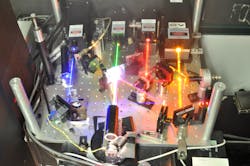SOLID-STATE ILLUMINATION: Four-color laser source produces high-quality white light
An enormous amount of effort is being expended worldwide in efforts to create more efficient white-light sources for general illumination. At the leading edge now are indium gallium nitride (InGaN)-based blue LEDs with phosphors, which have reached luminous efficacies up to 265 lm/W. The disadvantage of these devices, as with all nitride LEDs, is that their highest efficacies are reached only at low current densities (and thus low light outputs), due to the well-known problem of efficiency droop. This leads to higher costs, as more LEDs are then required to achieve the highest efficiencies.
In contrast, lasers do not have efficiency droop: Instead, they reach their best performance at high current densities. Some IR laser diodes can reach efficiencies greater than 70%, while high-power blue InGaN laser diodes have reached efficiencies up to 24.3%—and have potential to reach much higher figures.
With this in mind, researchers at the University of New Mexico, Sandia National Laboratories (both of Albuquerque, NM), and the National Institute for Standards and Technology (NIST; Gaithersburg, MD) have created a laser-based white-light illuminator specifically to test its color-rendering quality. Rather than combining a blue laser with a phosphor, similar to white LEDs, the researchers instead combined narrowband laser light of different colors, an approach that could potentially reach higher efficiencies and allow color adjustment as well. They chose four colors (red, green, yellow, and blue) and mixed them via a diffuser.
The white-light laser source incorporated a red laser diode emitting 800 mW at 635 nm with a linewidth less than 2 nm; a sum-frequency-generation yellow Nd:YAG laser emitting 500 mW at 589 nm and with a linewidth less than 0.2 nm; a green frequency-doubled Nd:YAG laser emitting 300 mW at 552 nm and with a linewidth less than 0.2 nm; and a frequency-doubled Nd:YVO4 (vanadate) laser emitting 300 mW at 457 nm and with a linewidth less than 0.2 nm (see figure). The lasers were pulsewidth-modulated at 781 Hz for individual brightness control. Their light was combined and diffused using a piece of glass from a soft-white incandescent bulb and a piece of ground glass.
Preference testing
It is a common assumption that broadband white-light sources provide a higher-quality white output than sources that include narrow spectral lines; the researchers set out to test the validity of this assumption. They compared the laser illuminator to four other white-light sources: an incandescent lamp, and warm-white, neutral-white, and cool-white LEDs. The incandescent lamp has a smooth, line-free spectrum, while the LEDs all have spectra containing a somewhat narrow blue line (the LED output) and a broad longer-wavelength hump (the phosphor output).
In the comparison, the laser outputs were tuned to match both the chromaticities and the illuminances of the sources to which they were compared. Side-by-side viewing booths were prepared, one containing the four-color laser source as well as all the comparison sources, and the other containing only the comparison sources. Bowls of fruit and wrapped candy were placed in each booth for viewing. Random pairings of light sources were chosen for each comparison; each test subject rated which he or she preferred and, on a scale, the strength of the preference.
When a light source was compared to itself, the data resulting from many comparisons showed a single symmetric peak about the “no preference” point. When the laser light source was compared to some other source, the resulting cumulative data showed two peaks: one slightly to the left and one slightly to the right of the “no preference” point. Upon post-test interviews of the subjects, the researchers learned that this was a result of the laser illuminator’s higher color saturation: Some subjects preferred more saturation, while others preferred less.
High-quality white output
Overall, the test subjects slightly preferred the laser source over the warm- and cool-white LEDS, slightly preferred the incandescent lamp over the laser source, and had no clear preference between the neutral-white LED and the laser source. The results show that a four-color laser source has no disadvantage over conventional sources when it comes to the quality of its white-light output. This is good news, as further improvements to visible laser diode efficiencies could eventually result in a laser-based white-light source with a luminous efficacy far greater than any LED.
REFERENCE
1. A. Neumann et al., Opt. Exp., 19, S4, A982 (July 4, 2011).

John Wallace | Senior Technical Editor (1998-2022)
John Wallace was with Laser Focus World for nearly 25 years, retiring in late June 2022. He obtained a bachelor's degree in mechanical engineering and physics at Rutgers University and a master's in optical engineering at the University of Rochester. Before becoming an editor, John worked as an engineer at RCA, Exxon, Eastman Kodak, and GCA Corporation.
